Browse Exhibits (27 total)
Riverside-Normal City Historic Design Guidelines

Professor JP Halls ARCH 441/541 Preservation policy course compiled a set of historic design guidelines as neighborhood stakeholders plan to create a local historic district for a portion of the neighborhood and to assist in the continued long-term architectural preservation of the Riverside neighborhood.
Credit To:
Dylan Crites
Kendall Johnson
Abby Marshall
Annie Bedwell
Ellie Morinville
Emily Armstrong
Haley Swindle
Kalie Matherly
Maria Moore
Molly Hollcraft
Sandra Gofton
Caitlin Lehman
Caldwell-Dennis House Adaptive Reuse Feasibility Study
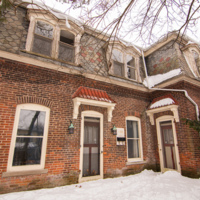
Professor JP Halls ARCH 607- Historic Preservation Studio course created an adaptive reuse plan to examine the feasibility of rehabilitating the historic Caldwell-Dennis residence into transitional housing for women reentering society.
Credit to:
Cooper Shields
Abby Marshall
Robert Jonet
Caitlin Lehman
Nancy Jones
Haley Swindle
BetterTogether:Police-Community Engagement in Muncie
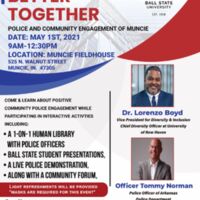
This event will showcase the importance of police-community engagement within the Muncie community. It will also provide a template for future positive police-community relations in an interactive, mutual trust building manner.
Ball State student presentations will also highlight ways in which law enforcement-community relations could be sustained.
Instructor: Dr Warren-Gordon
Course: Criminal Justice and Criminology 495
Ball State University
Transforming the Muncie Mall into a Community Sustainability Hub
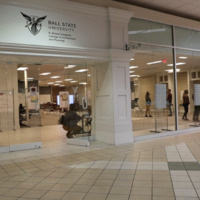
Transforming the Muncie Mall into a Community Sustainability Hub
Students in this course have worked to develop proposals to transform the Muncie Mall into a sustainability center for the Muncie community. Interdisciplinary student teams used specialized disciplinary knowledge and skills to plan projects that they have presented and discussed with local business and government leaders.
Community partners for this course are:
Jay Julian of the Muncie-Delaware County Chamber of Commerce; Traci Lutton of the Muncie-Delaware County Economic Development Alliance; and Mayor Dan Ridenour of the City of Muncie Office of the Mayor.
Other course partners:
Tim Kean, Second Harvest; Ashley Mann, Minnetrista; Josh Gruver, Muncie Food Hub Partnership; Jon Anderson, Muncie Sports Commission; Zane Bishop, City of Muncie.
Students:
Conner Becker, Brittan Brady, Devin Bridget, Jessica Carroll, Georgia Cushing, Jack Field, Hannah Hubble, Alvin Languerre, Alexandra Lawburg, John Maegerlein, Caitlin Osburn, Erin Powell, Michael Shirley, Carter Solivan, Dominic Zelli
Putting Downtown Muncie on the Map: Cartography for Businesses, Arts and History
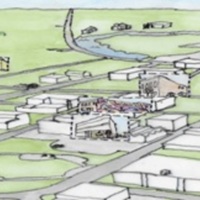
GEOG434 (Maps, Environment, and Society) is an immersive learning class offered in the spring semester of 2021 that aimed to give support to the local businesses and cultural organizations and institutions in Downtown Muncie in their effort to promote economic activities, inform about downtown and attract people to the area. Students from the Geography Program and neighboring fields applied their cartographic skills and GIS knowledge to create interactive and visually attractive maps that invited residents and tourists to visit and recognize Downtown Muncie as a valuable place for shopping, leisure and entertainment. Under the guidance of Professor Dr. Jörn Seemann from the Department of Geography, a group of 21 students worked together with local partner institutions and associations such as DWNTWN Muncie and Muncie Arts & Culture Council to discuss and develop cartographic and other visual material (e.g. paper maps and interactive online maps) that can be used to advertise the Downtown businesses and highlight the qualities and attractions in this area.
Using Nature to Redesign Places of Worship in Muncie, IN

This project integrates environment, economy, and society to develop more sustainable and healthy places of community worship. Adhering to the professional code of ethics for interior design and construction management (health, safety, and welfare), undergraduate students from the Interior Design (ID) and Construction Management (CM) programs manage an active, engaged, learner-centered environment as they explore Muncie’s diversity of cultures and faith traditions to redesign two places of worship in an environmentally sustainable manner.
This project is two semesters long:
In Spring 2021, approximately 30 students from the sophomore-level IDES 225 History of Interior Design class (a required course in the Interior Design major) and 20 students from the sophomore-level CM 262 Electrical Construction (a required course in the Construction Management major) will conduct observations and interviews at the Islamic Community Center (ICM) and Riverside United Methodist Church(RUMC). The students will survey both buildings for existing biophilia (i.e. use of natural dynamic/diffused light, blurring boundaries of indoors/outdoors, natural textures, presence of water, airflow, natural scents, scattered vegetation, plant-life, areas of refuge, etc.). Using devices such as thermal cameras and light meters students will record existing efficiency conditions (i.e. energy, wibd, hydro, solar, people, etc.) onto their iPad at the sites. Students will interview faith leaders to identify and document sustainable patterns of the building use and develop a post-occupancy measure use while evaluating biophilic design adaptations.
In Fall 2021, the same students from IDES 225 will advance to junior-level IDES 324 Interior Design Studio 3 (another required course) and partner with 20 new students from sophomore CM 261 Mechanical Construction (another required course) to redesign both places of worship. The CM students will generate an energy model for each building based on its current physical conditions and operational routines, and the ID students will develop a variety of approaches to renovate the two buildings, learning from nature to focus on biophilic/sustainable techniques. The ID and CM, student cohorts will work together to present their iterations to both community partners; using nature as a model, the final design solutions for each building will show the benefits of enhanced biophilia as well as include an energy efficiency plan showing an initial cost versus savings. Students also will survey building users to gauge their perceptions and willingness to invest in and adopt these approaches; students’ analysis of the data collected will examine correlations between parameters related to renovation and parameters related to users’ willingness to adopt the proposed changes.
During the course of the project, a guest expert on biophilia will share in the classroom to help guide the design; the PIs have confirmed Sonja Bochart (IIDA, LEED AP BD+C, WELL AP), Principal of Sheply Bulfinch Arizona, as a presenter. With over 50 biophilic workshops conducted, Bochart will develop a specialized workshop for the CMID students working on this IL project focusing on Biophilic by Design: Spirit of Place. Facilitated to meet the requirements for Biophilic Design, as it relates to the WELL Building Standards, the hands-on, inspirational and educational workshop will be project specific to RUMC and ICM and facilitated in an educational, research-based, mindful, creative and multi-sensory approach.
The final result, presented in Fall 2021, will be a biophilic project design strategy aimed to positively affect human and ecological health and well-being for the RUMC and ICM facilites.
Virtual Play Creation
Students work in groups to write, direct and perform a piece of virtual theatre with the goal to create a set of "best practices" for virtual theatre as a partnership with the Pheonix Theatre. Students are divided into three groups to pitch three unique Zoom play proposals and develop one selected proposal into a 1-3 minute, 3-6 minute, and finally an 8-20 minute play. Each group will present their full play at the end of the semester in a virtual play showcase put on by the class. Throughout the semester, students complete both self-assessments and peer assessments to measure professionalism, problem-solving, collaboration, adaptability, and resilience.
Student Participants:
Shelby Brown, Myra Carleton, Paige Demba, William Freeman, Mason Golden, Anthony Hayes, Sarai Heylmun, Lizzie Nguyen, Mario Noto, Liz Patton, Maggie Perisho, Gayle Radwick, Janae Robinson, Becca Schaefer, Jordan Shaw, Chase Strange, Grace Wagner, Nor White, Arianna Zielinski
Writing for Change
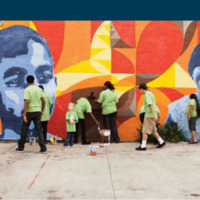
“Writing for Change” is comprised of three year-long, immersive sections of First-Year Composition. During the 2020-2021 year, the pilot courses were offered in partnership with the Muncie Mission, Beyond I Can and the YWCA of Delaware County. Students spent one semester learning about ethical community engagement and growing as composers of a variety of texts. They interacted with their community partners to learn about the issues most important to their mission and conducted primary and secondary research on these issues. During the second semester, students worked to determine how writing could support the work of their community partners by creating documents seeking financial backing, facilitating organization and contributing to community awareness. They formulated a strategic plan and collaborated to create a series of texts on behalf of their partner organization. Students wrote proposals, designed brochures, and created web content for their community partners. By asking students to fulfill real-world needs, these courses developed students’ sense of social responsibility and understanding of how to write for specific audiences and purposes.
- Muncie Mission - Dr. Darolyn Jones
- Beyond I Can - Dr. Laura Romano
- YWCA of Delaware County - Dr. Kathryn Ludwig
Brightfield for the Bright Future
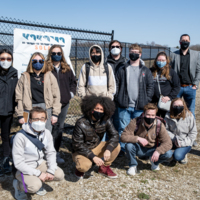
In Spring 2021, ten second-year urban planning major students, Adam Coleson, Lauren Doppke, Michael Grossniklaus, Elise Jones, Kaelyn Leach, Enzo Lundy, Mattew Pytel, Kaylie Slate, Eric Snowden, and Christian Terrell, in PLAN 203 Regional Analysis and Design of Ball State University conducted solar potential analysis for brownfields in Muncie, Indiana. In collaboration with Sierra Club Hoosier Chapter with the generous support from Ball State University’s Immersive Learning Office, students applied Geographic Information Systems (GIS) to study the ownership of the brownfields, current land use and zoning ordinances, preexisting conditions, and then analyzed solar PV potentials using publicly available PV watts tool developed by the US Department of Energy.
BSU Sociology Capstone Immersive Learning Project

Partnering with Second Harvest Food Bank in Spring 2021, this Immersive Learning Project aimed to examine the needs of the community through application of sociological knowledge to synthesize research and literature. Students in this Immersive Learning Project collected data from Second Harvest "Big Idea" Events in the form of surveys and interviews. They then synthesized their findings and presented the research to the community partner: Second Harvest Food Bank. Second Harvest will then use this research to earn grants and gain a better understanding of how COVID-19 impacted food insecurity in Indiana.
Student contributors:
Kirby Barger, Alex Dixon, Bradley Fletcher, Madeleine Hollinger, Megan Jones, Emma Moeller, Gracie Mulholland, Sarah Orr, Jon Sorgenfrei, Joe Trentadue, Garrett Watkins, Schaefer Watson, and Kate Winslow.
Special Thanks to Robbie Mehling for Photography.